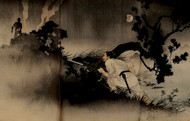The Origin of Togakure-Ryū
Posted by Sydney Brackins on Mar 23rd 2018

History & Lineage
According to historians Togakure-ryū originated in 1162 in the Mie Prefecture with its creator, Daisuke Nishina, as a
way of fighting in the war between the Genji and Heike (Taira) clans. The style itself would go on to be known as the
origination of Ninjutsu and its various fighting styles. Nishina was a Samurai and a member of the Genji clan, which
had been staging a revolt against the Heike clan because of their oppression by the Genji people. The revolt,
however, was crushed and Nishina fled his home village of Togakure in the Shinano Province to save his children.
Hatsumi Masaaki indicates that Nishina then changed his name to Togakure to reflect where he had come from.
Togakure then settled down in the forests on the Kii Peninsula in the Iga Province. This account indicates that it was
there that Togakure met Kain Dōshi, a warrior-monk who had been politically exiled from China. From Kain, Togakure
learned the fighting styles of China and Tibet and put aside his 'Samurai Code'. Articles written using Hatsumi as a
source indicate that Togakure's first successor was his son, Rokosuke. They also indicate that he trained a deshi
called Shima, who would become the third master of the style after Rokosuke.
Since historical times, the Togakure-ryū style has been passed down through the years until it was given mastership
to Shinryuken Toda, the 32nd Sōke of Togakure-ryū. He began teaching the style to his grandson, Toshitsugu
Takamatsu, since Takamatsu was five in 1893. When he turned 19, Takamatsu was announced as the next
successor of the Togakure-ryū style, becoming the 33rd Sōke. After this pronouncement, Takamatsu decided to
spend a year meditating in the mountains between Kyoto and Nara. Upon his return, he set out again, this time to
China where he spent time in the courts of nobles as an important adviser because of his extensive knowledge from
his Ninja training. It is stated by Hatsumi that because of a series of incidents that occurred throughout China,
Takamatsu became infamous throughout the region by the age of 25.
Style
As a Ninjutsu tradition influenced by the Samurai Martial Arts of the Sengoku period, the style of Togakure-ryū
consists of physical escapes and evasion techniques (Ninpo Taijutsu), as well as a series of sword attack patterns, or
Biken Kata. However, much of the art involves techniques of geography, meteorology, swimming, signaling, potion-
making, fire-starting, concentration, disguise, impersonation, and other forms of knowledge suited for the unique
information-gathering and infiltration roles of the Ninja.
Togakure-ryū's Ninpo Taijutsu is fundamentally different from other styles of Japanese Martial Arts that are currently
taught in Japan and around the world. This is largely because, unlike these other styles, Togakure-ryū does not have
a tightly regimented organizational structure. Togakure-ryū contains some historical kata, which are like the training
in Judo and Aikido in that they require an attacker to initiate the movements. Much of the formality that other styles
contain is also not present in modern Togakure-ryū. Stephen K. Hayes, famed Bujinkan instructor, explained that it is
likely this "freer, more flexible structure" that makes it different, as the style has an atmosphere where "questions are
encouraged, but there isn't one pat answer for every question."
In a different manner, modern Togakure-ryū has resemblances to other martial arts styles as well in that there is
certain "footwork and dynamics" that all styles utilize because of how the human body moves and works. Stephen K.
Hayes stated that a main goal of the style is Shin Shin Shin Gan (God's eyes, God's mind) which refers to the
"development of a broad vision or knowledge". This is in relation to learning to anticipate the moves that an opponent
will make and to also be able to sense oncoming danger.

